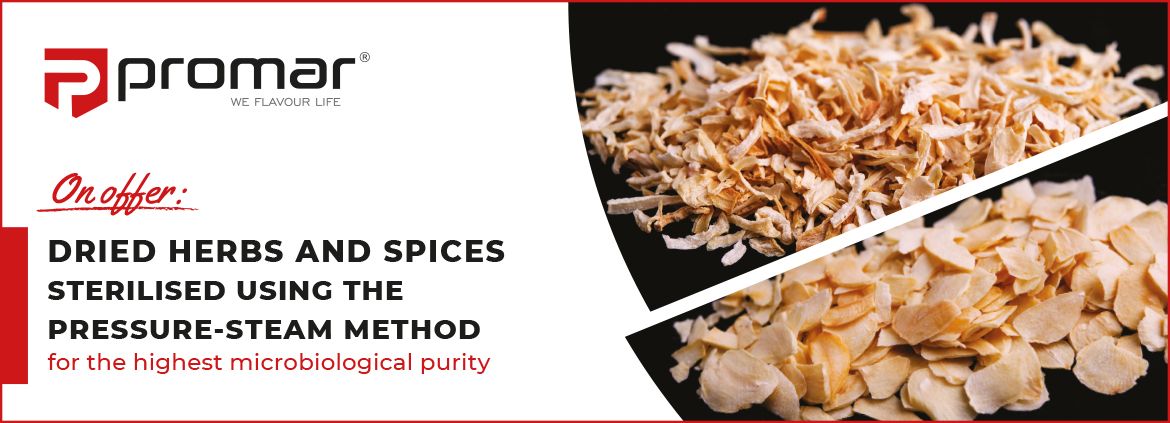On the subject of dried herbs and spices, there is a lot of information on their health-promoting and antioxidant properties. It is interesting to note that the drying process inhibits the growth of microorganisms, but.... it does not destroy them completely!
In the following post, we publish a study by Piotr Kulawik, PhD, on hidden microbial contamination, we invite you to read it!
Dried spices and herbs as a source of latent microbial contamination.
Dried spices and herbs are one of the key ingredients in most fish preparations giving them distinctive organoleptic characteristics. In addition to their sensory qualities, dried spices and herbs contain bioactive substances that exhibit health-promoting, antioxidant and antimicrobial properties. Therefore, it may seem surprising that dried spices available on the market are usually much more contaminated than fresh fish meat. According to studies, the contamination of dried spices and herbs with total microbial counts is often in the range of 106 - 108 cfu/g and these values are constant regardless of whether the raw material available in India, Nigeria, South Africa, Canada, USA, the Netherlands, Germany or Poland was analysed. Interestingly, often the highest levels of microbial contamination were found in spices that are commonly considered antimicrobial, such as garlic, chilli powder and pepper. Additionally, dried herbs and spices are often reservoirs of food pathogens such as Listeria monocytogenes, Escherichia coli, Salmonella spp. Staphylococcus aureus, Clostridium perfringens, Bacillus cereus, Shigella spp, Vibrio spp, Klebsiella spp and many others.
Microbial contamination of spices is most often caused by the contact between the spices and the soil during cultivation and later during the crushing and drying process. The drying process itself inhibits the growth of microorganisms, but is not sufficient to cause their complete destruction. This means that the micro-organisms present in spices can grow back once they are added to a product with a high water content, which fish definitely is. Particularly important from the point of view of food safety is the presence of a large number of spore-forming microorganisms that show considerable resistance against chemical (disinfectants, salt, etc.) as well as physical (thermal and non-thermal) food processing methods. The native microflora of fresh fish predominantly consists of temperature-sensitive microorganisms, while the addition of spices results in the introduction of pasteurisation-resistant microorganisms into the final product, causing a risk to food health safety. Various studies have shown the presence of spore-forming micro-organisms at levels ranging from 102 up to as high as 108/g in tested samples of dried spices and herbs.
Micro-organisms from spices and herbs caused food products to spoil during their best-before date and therefore the products had to be withdrawn from the market. This applies even to sterilised canned food. Furthermore, as microbiological contamination of spices will most often vary from batch to batch of a given raw material, this causes problems with standardisation of the final product and a shortened shelf life. This forces producers to use more stringent thermal processing conditions (time/temperature) or to use additional non-thermal food preservation methods. This can result in reduced product yields, longer production cycles, increased production costs and changes in the organoleptic parameters of the product.
Depending on the growing region, the process of harvesting and pre-processing of spices, as well as the level of hygiene in the plants where this processing takes place, varies. As many spices are produced in remote parts of the world, detailed quality control and implementing hygiene procedures during harvesting and drying are much more difficult or even impossible. For this reason, some importers and producers of spices choose to introduce an additional decontamination process for spices before placing them on the market. Among these methods are irradiation, fumigation, microwave sterilisation and steam sterilisation. Each of these methods unfortunately has its drawbacks. Irradiation, while effective, is problematic from a legal point of view, and requires high investment and additional information on the product label. Fumigation with disinfectants, mainly ethylene oxide, propyl oxide or methyl bromide, has been banned in the EU due to the formation of mutagenic and carcinogenic compounds in the product. Microwave sterilisation is problematic due to the irregular heating of the product associated with the low moisture content of the raw material and the loss of aromatic and active compounds of the sterilised spices.
Steam sterilisation, is the most popular and effective method of preserving dried herbs and spices, however, it often requires prolonged processing time and may change the sensory parameters of the product. A further development of this method is pressure-steam sterilisation, in which the product is disinfected several times using steam at a temperature of 120-140oC for short periods of time (from several to several dozen seconds), which minimises the loss of bioactive and aromatic substances of spices while reducing the number of microorganisms even by several logarithmic cycles. However, this method requires high investment and optimisation of the entire process for each spice separately, which is why it is used rather by large, specialised companies involved in the production of spices and herbs.
In Poland, such a method has been used recently by PROMAR PPH Sp. z o.o., which, after more than two years of research and analysis, implemented the pressure-steam sterilisation method for dried herbs and spices, particularly garlic and onion flakes. This has enabled the company to introduce a guarantee of maximum microbial contamination in its spices at levels below 104 and 102 cfu/g for total microbial counts and yeast and mould counts, respectively, so that the use of such spices in the final product increases product safety.
Piotr Kulawik, PhD, Professor URK
udostępnij udostępnij





